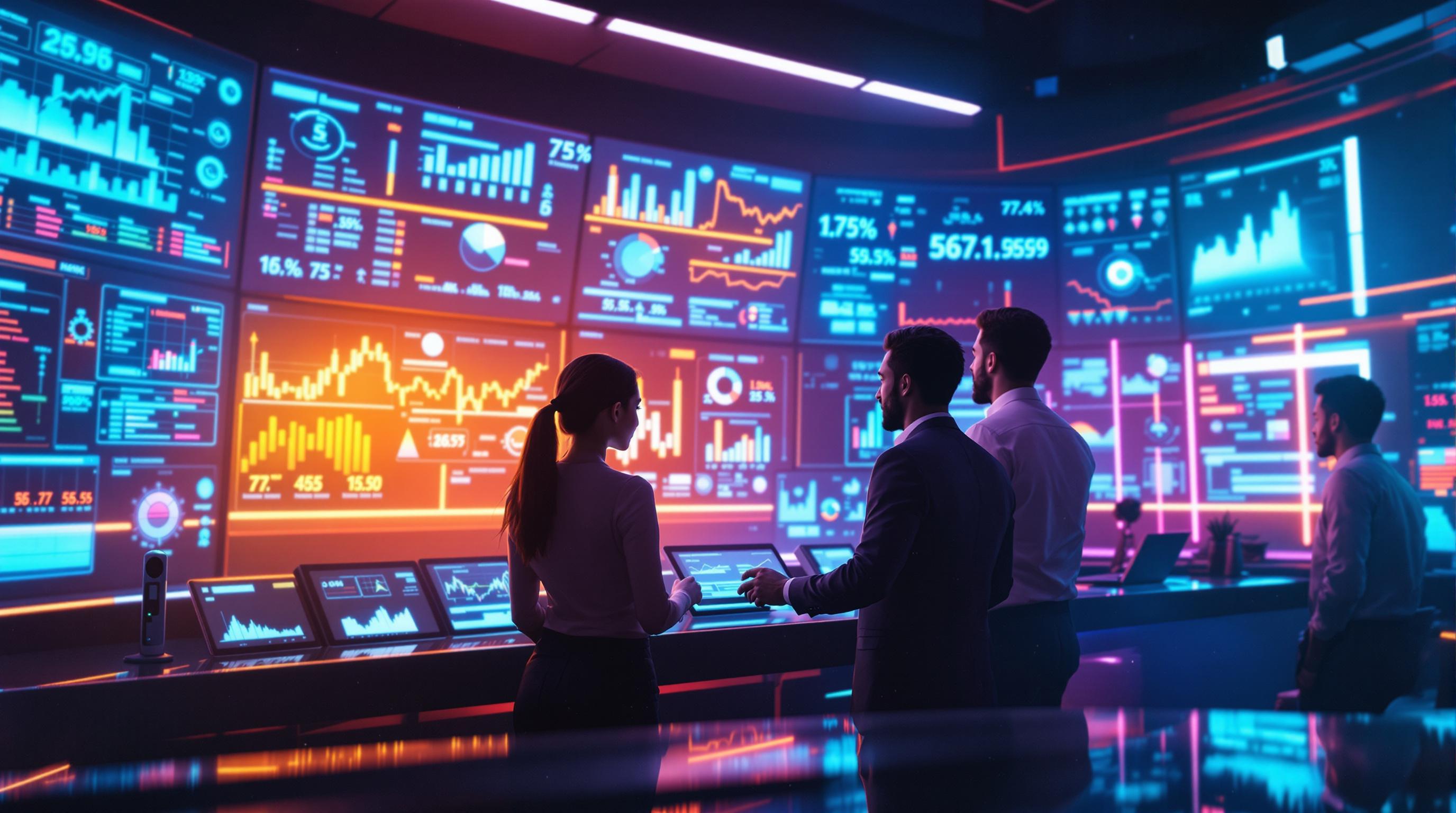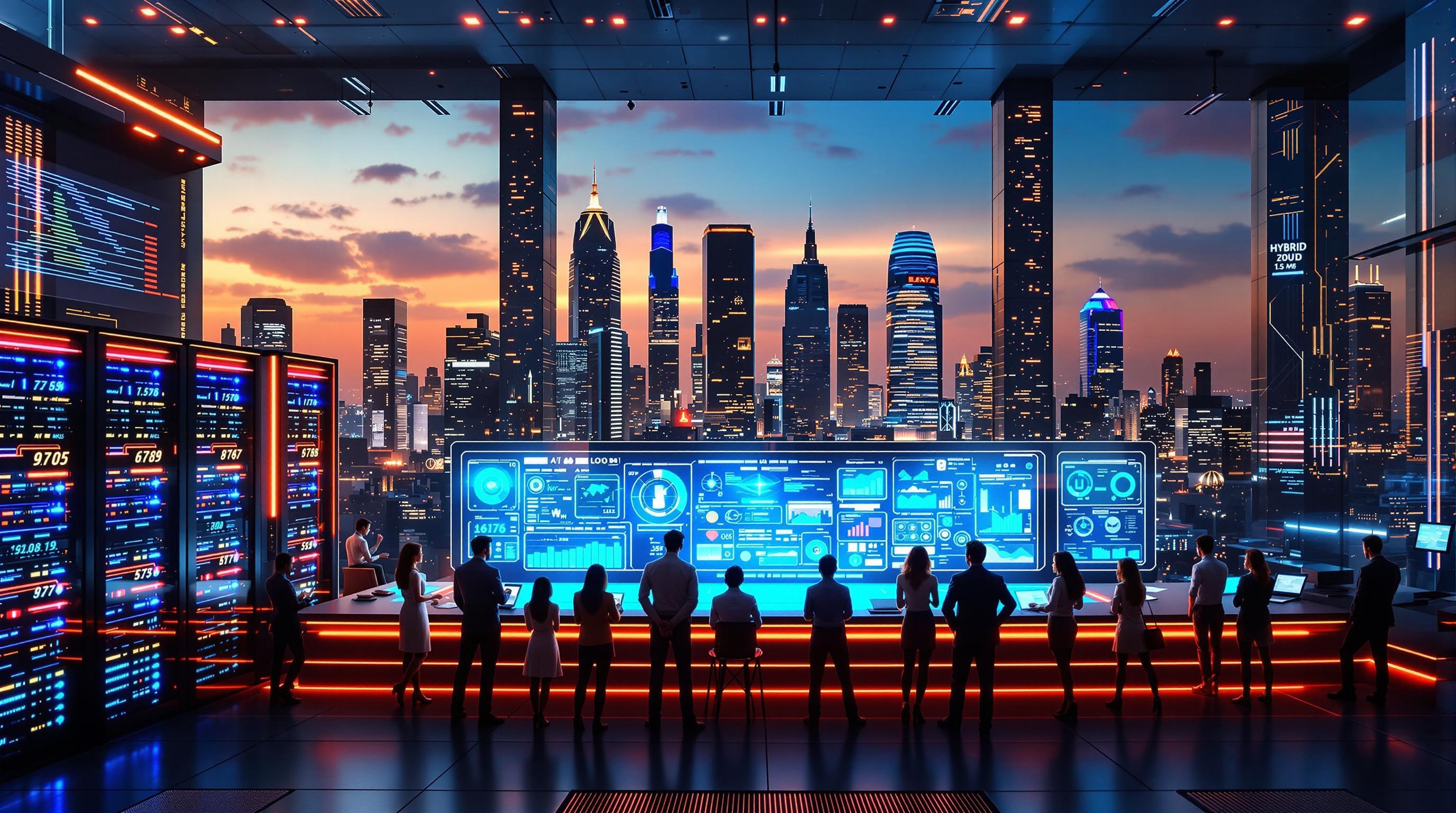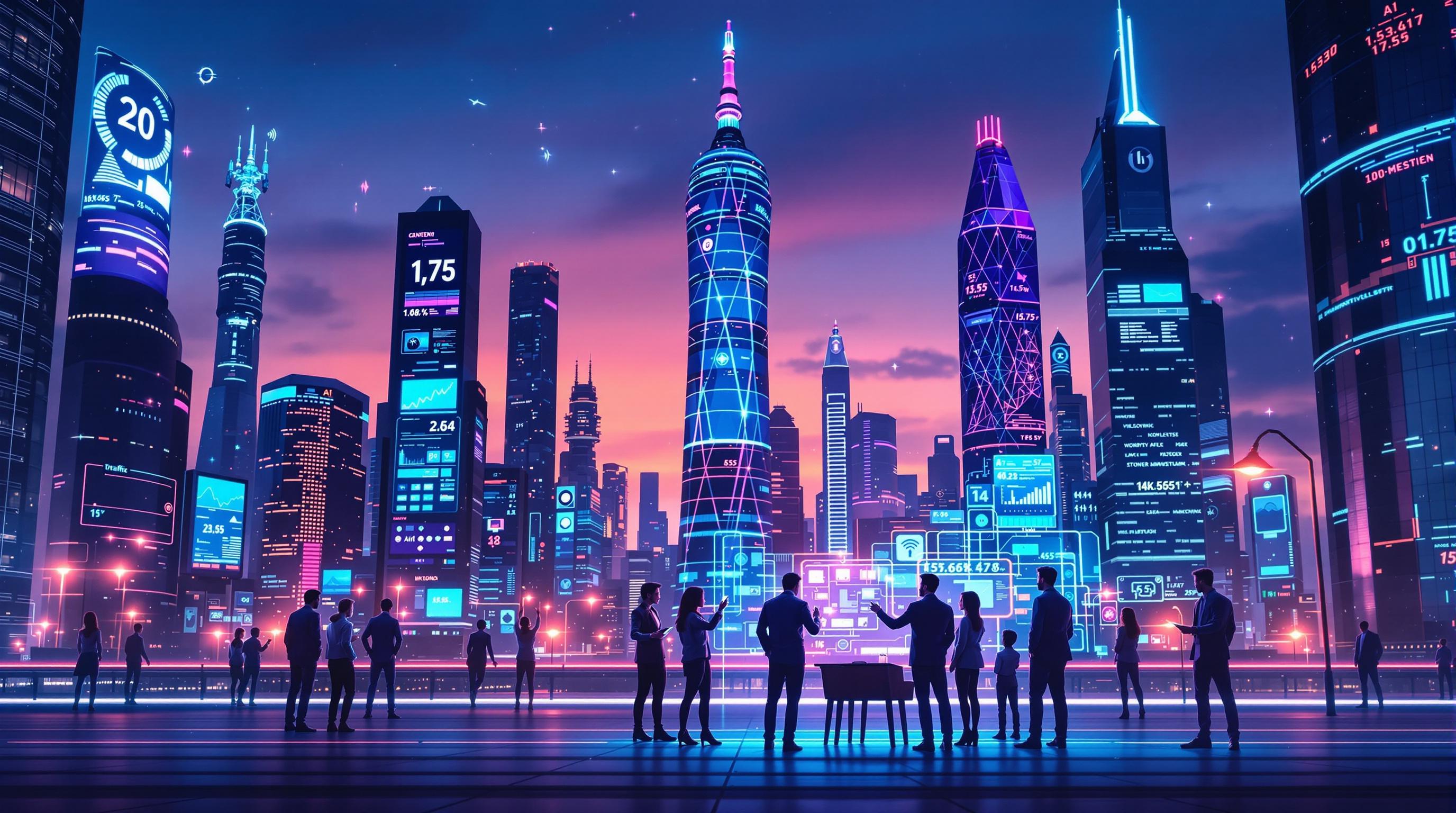Multi-agent systems (MAS) are transforming how tasks are managed by enabling decentralized decision-making and efficient coordination. From emergency response to warehouse logistics and online marketplaces, MAS allow independent agents to work together toward shared goals. Here's a quick overview of the 7 top MAS applications:
- Swarm Robotics: Perfect for search and rescue, using autonomous robots for mapping and hazard detection.
- Warehouse Robotics: Streamline operations with task allocation, route planning, and real-time collaboration.
- AI in Marketplaces: Automates pricing, inventory management, and demand forecasting.
- Reinforcement Learning Models: Agents learn and adapt to dynamic environments for better task coordination.
- Distributed Problem-Solving: Breaks down complex tasks into smaller, manageable units.
- Federated Learning: Focuses on privacy by enabling decentralized learning and secure data sharing.
- Multi-Agent Robotics: Efficiently handles large-scale industrial or emergency tasks with autonomous robots.
Quick Comparison
| Application | Key Benefit | Example Use Case |
|---|---|---|
| Swarm Robotics | Real-time hazard mapping | Search and rescue missions |
| Warehouse Robotics | Optimized task distribution | Inventory management |
| AI in Marketplaces | Dynamic pricing and inventory | Online retail platforms |
| Reinforcement Learning | Adaptive decision-making | Traffic systems |
| Distributed Problem-Solving | Parallel task execution | Emergency management |
| Federated Learning | Privacy-focused collaboration | Smart traffic systems |
| Multi-Agent Robotics | Scalable task handling | Manufacturing automation |
These systems excel in flexibility, scalability, and efficiency, making them essential tools for industries tackling complex coordination challenges.
Multi-Agent Systems for Warehouse Applications
1. Swarm Robotics in Emergency Response
Swarm robotics offers a cutting-edge method for handling emergency situations by using multiple autonomous robots that work together seamlessly. These systems are especially effective in search and rescue missions, thanks to algorithms designed for real-time mapping and identifying hazards.
What makes swarm robotics so powerful is its ability to quickly deploy numerous units across vast areas while maintaining smooth communication. Each robot independently examines different sections of an environment, sharing crucial data with the group. This creates a detailed map of the terrain and pinpoints areas that need immediate action [2].
| Capability | Emergency Response Application |
|---|---|
| Autonomous Navigation | Exploring hazardous areas independently |
| Real-time Data Sharing | Building terrain maps collectively |
| Coordination Algorithms | Ensuring robots work efficiently together |
| Scalable Operations | Adding more units as needed without issues |
The system's distributed design ensures that even if some robots fail, the mission can continue. Shared data allows the swarm to adjust in real-time to changing conditions [2][4].
"Multi-agent systems excel in dynamic, large-scale problem-solving by leveraging multiple agents." - Catio, Multi-Agent Systems Fundamentals [3]
However, successful use of swarm robotics depends on reliable communication, effective coordination, and the ability to adapt to unexpected challenges. The scalable nature of these systems is especially useful in large-scale disasters, where quick response and wide coverage are essential [2][4].
Looking ahead, researchers are working on improving communication protocols to make these systems even more reliable in critical situations, while also reducing risks for human responders [3][4]. This adaptable design is also driving advancements in industries like logistics and marketplaces.
2. Robotics for Warehouse Operations
Autonomous robots, powered by multi-agent systems, are reshaping warehouse operations. These systems allow robots to work together effectively, managing tasks like job allocation, route planning, and workload distribution in real time. The result? Increased efficiency across large-scale facilities.
Each robot operates independently, making decisions based on its environment while staying in sync with other units. This setup reflects the essence of distributed decision-making, where coordination among agents drives smooth operations [3].
| Function | Implementation | Benefit |
|---|---|---|
| Task Distribution | Assigns picking and sorting autonomously | Eases bottlenecks |
| Path Optimization | Plans routes in real time | Reduces collision risks |
| Resource Management | Balances tasks dynamically | Boosts throughput |
| Adaptive Scaling | Deploys robots as needed | Handles demand spikes |
The architecture behind these systems is key. Robots need to sense their surroundings, process data, and collaborate to solve logistical challenges [3]. This distributed model enables round-the-clock operations, far surpassing the limits of manual systems.
"Multi-agent systems (MAS) enable warehouse robots to work collectively, leveraging their unique capabilities to achieve shared logistical goals." [1]
One major perk is scalability. Operators can add or remove robots as demand shifts - especially during busy periods - without interrupting workflows [2]. To make this possible, systems must include:
- Clear goals and adaptable decision-making
- Reliable communication between agents
- Ongoing monitoring of interactions
Advanced algorithms play a critical role in avoiding resource conflicts and maximizing overall performance [2]. AI techniques like reinforcement learning continue to refine these systems, making them even more efficient and flexible [5].
Interestingly, the same principles of multi-agent coordination apply beyond warehouses. For instance, in digital spaces like online marketplaces, agents help streamline processes and improve user experiences.
3. AI Systems for Online Marketplaces
Multi-agent systems are reshaping online marketplaces by using AI to handle complex tasks like pricing and inventory management. These systems consist of multiple independent agents working together to manage marketplace operations efficiently, from real-time adjustments to long-term planning [2].
What makes these systems so effective is their ability to adapt quickly to market changes. Each agent operates on its own but stays in sync with others, allowing for fast, distributed decision-making. This creates a marketplace that's both responsive and efficient [3].
| Function | Market Impact |
|---|---|
| Price Optimization | Adjusts prices in real time based on demand |
| Inventory Control | Keeps stock levels updated and managed |
| Demand Forecasting | Predicts trends to improve planning |
| Transaction Processing | Automates and speeds up order fulfillment |
These systems shine because they can handle multiple tasks at once. Using advanced algorithms, they can negotiate prices, manage stock, and adjust offerings - all based on real-time data [6].
One standout feature is their ability to scale. Multi-agent systems can process millions of transactions daily, even during high-traffic events like flash sales. Their distributed design ensures smooth operation under heavy loads [2].
Strong communication between agents is crucial for these systems to work. This coordination allows them to handle key functions like updating inventory and adjusting prices without missing a beat [2].
These systems are especially powerful in fast-changing markets. By leveraging machine learning and real-time data, they can quickly respond to new demands, keeping everything running smoothly [3].
The same principles behind multi-agent systems in marketplaces are also being applied in other areas, like reinforcement learning models, to further enhance decision-making.
4. Multi-Agent Reinforcement Learning Models
Multi-agent reinforcement learning (MARL) is transforming how task coordination systems work. Unlike traditional multi-agent systems, which focus on optimizing marketplaces, MARL allows agents to learn and adjust in ever-changing environments. By decentralizing decisions and fostering cooperative learning, MARL improves the efficiency of multi-agent systems.
MARL systems often follow a hierarchical structure, offering clear benefits:
| Level | Role |
|---|---|
| Strategic | Aligns and manages system-wide goals |
| Tactical | Allocates resources effectively |
| Operational | Executes tasks and adapts as needed |
This structure allows agents to operate independently while still working toward shared objectives. Reward systems play a key role here, helping agents balance their own goals with the larger system's needs.
Three essential components form the backbone of effective MARL systems:
| Component | Purpose | Implementation |
|---|---|---|
| Communication Protocols | Ensures agents work together | Real-time data exchange methods |
| Reward Structures | Shapes learning behavior | Tied to system-wide objectives |
| Decision Algorithms | Handles feedback from the environment | Uses adaptive learning techniques |
MARL is particularly well-suited for managing complex, large-scale operations [1][2]. Its distributed approach ensures efficient task management, even as systems grow or encounter unexpected challenges.
One standout feature is real-time adaptation. Agents can instantly tweak their actions based on feedback, keeping operations running smoothly across applications like traffic systems and industrial automation [2].
sbb-itb-f88cb20
5. Distributed Problem-Solving in Artificial Intelligence
Distributed problem-solving systems in artificial intelligence (AI) focus on breaking down large tasks into smaller, coordinated efforts. These systems, often part of Distributed Artificial Intelligence (DAI), use decentralized decision-making to allocate resources and handle complex challenges efficiently.
DAI systems are used across various industries, from logistics to emergency management. Their design allows multiple agents to operate independently while ensuring the entire system works in harmony.
| Component | Function | Impact |
|---|---|---|
| Task Decomposition | Divides tasks into smaller units | Allows parallel processing |
| Agent Coordination | Allocates resources and manages timing | Avoids conflicts and bottlenecks |
| Real-time Communication | Shares information across agents | Enables quick, adaptive responses |
| Conflict Resolution | Resolves competing priorities | Ensures smooth operations |
Advanced communication methods play a key role in these systems. Agents share critical information, adjust to real-time changes, and coordinate actions effectively. Security, however, remains a top concern. As networks grow, encryption techniques and access controls are being developed to safeguard data without impacting performance [2][3].
"Multi-agent systems have emerged as a powerful paradigm for tackling complex, distributed decision-making challenges. These systems leverage the collective intelligence of multiple autonomous agents, each contributing their unique capabilities to achieve common goals." [1]
DAI systems are particularly flexible in industrial settings. Agents can be added or removed as needed, allowing the system to handle varying workloads and complexity levels [2][1].
Recent advancements in DAI have focused on improving algorithms, enabling agents to adjust their behavior based on environmental changes or new data. This ensures these systems remain efficient and resilient, even in dynamic and unpredictable scenarios [2][3].
6. Federated Learning for Multi-Agent Systems
Federated learning brings a new approach to multi-agent systems by enabling decentralized learning. It ensures sensitive data stays secure while cutting down on communication overhead. This makes it a great fit for scenarios where privacy is a top priority.
| Feature | Advantage | Example Use Case |
|---|---|---|
| Distributed Learning | Eases central server workload | Smart traffic systems |
| Data Privacy | Keeps sensitive data secure | Healthcare networks |
| Reduced Communication | Cuts data transmission by 90% | Edge computing |
| Adaptive Decision-Making | Quickly adapts to changes | Industrial automation |
This system architecture promotes efficient knowledge sharing while tackling challenges in coordinating multiple agents. Each agent processes data locally and shares only model updates, keeping sensitive details private and slashing communication costs. These features have proven especially useful in fields like healthcare and finance [3].
Because it’s distributed, federated learning can scale to accommodate hundreds or even thousands of agents without overloading central resources [2]. One standout example is a healthcare consortium that used this method to develop accurate predictive models while safeguarding patient privacy.
Recent progress has improved the system's ability to handle unevenly distributed data across agents, making it better suited to real-world applications. This has been particularly impactful in smart cities, where environmental factors can vary widely from one area to another.
Federated learning also pairs well with other AI techniques, unlocking new opportunities for complex decision-making. For instance, in smart traffic management, traffic lights act as independent agents. They learn from local data to optimize traffic flow without needing a central controller.
However, implementing federated learning in multi-agent systems comes with challenges. Organizations need to carefully manage data distribution and communication protocols. Success hinges on striking the right balance between model accuracy, resource efficiency, and security.
As this technology advances, its combination with robotics and automation is paving the way for solving even more sophisticated challenges, which will be explored next.
7. Multi-Agent Robotics for Complex Tasks
Multi-agent robotics systems are transforming how complex tasks are managed by enabling autonomous coordination and real-time decision-making. These systems are particularly useful in scenarios where multiple robots must collaborate while maintaining their independence.
In industrial automation, these systems help allocate tasks efficiently, minimize bottlenecks, and adapt to changing conditions. This makes them valuable across a range of applications, from manufacturing to highly specialized industrial tasks [2].
| Application Area | Key Capabilities | Impact |
|---|---|---|
| Manufacturing | Handling specialized tasks, Coordinating between robots | Smoother assembly processes |
| Search and Rescue | Making advanced decisions, Adapting in real time | Better emergency response |
| Industrial Processes | Allocating tasks dynamically, Optimizing resources | Greater operational efficiency |
The effectiveness of multi-agent robotics depends on their architecture. A well-designed system allows robots to perceive their surroundings, make decisions independently, and communicate seamlessly with other agents [3]. These capabilities are especially important in environments where conditions change quickly.
By breaking large tasks into smaller, simultaneous sub-tasks, these systems boost efficiency and lower the chances of failure. This distributed method also improves reliability and enables robots to handle complex operations in parallel [3][5].
Another advantage is scalability. New robots can be added without disrupting existing workflows [2][1]. This makes it easier for organizations to grow their operations while maintaining consistency. However, successful deployment requires robust communication protocols and careful resource management [2][3].
To make the most of these systems, organizations need to define clear goals for each robot and ensure proper coordination methods are in place. Regular monitoring of interactions helps avoid conflicts and ensures resources are used effectively. These advancements highlight the growing potential of multi-agent robotics in enhancing distributed decision-making across various industries.
Conclusion
Multi-agent systems are reshaping how tasks are coordinated by offering better efficiency, flexibility, and scalability - especially in situations where centralized methods fall short [2][4].
For instance, swarm robotics assist in mapping hazardous areas during emergencies, warehouse robots streamline operations, and AI-driven marketplaces adjust pricing and inventory in real time [2]. These applications have led to faster rescue efforts, shorter warehouse processing times, and more efficient markets. Such outcomes showcase their impact and pave the way for continued progress in automation and decision-making.
With new tools and platforms emerging, multi-agent systems are becoming more accessible. To succeed with these systems, organizations should prioritize effective communication, adaptive decision-making, and robust security measures [2].
As multi-agent systems evolve, they continue to expand the limits of computational tasks. Their growing refinement and accessibility will play a key role in shaping the future of automation and task coordination across various industries [1][3].
FAQs
What are the best multi-agent frameworks?
The ideal multi-agent framework depends on what you need for your project. Here are some of the top options, each excelling in different areas of multi-agent system development:
| Framework | Best For | Key Strength |
|---|---|---|
| Microsoft Autogen | Enterprise solutions | High scalability |
| OpenAI Swarm | Complex coordination | Advanced communication tools |
| CrewAI | Rapid prototyping | Simple and quick implementation |
| Vertex AI | Cloud integration | Works seamlessly with Google Cloud |
| Langflow | Visual development | Easy-to-use low-code interface |
These frameworks make it possible to build multi-agent systems for industries like healthcare and logistics, enabling efficient task distribution and coordination [6].
Where are multi-agent systems used?
Multi-agent systems are making a big impact by solving problems through distributed collaboration. In healthcare, they help analyze medical data faster and with greater accuracy [2]. Their applications span multiple industries, including:
- Healthcare: AI agents work together to monitor patients and analyze diagnostics, improving medical decisions [2].
- Logistics: Autonomous robots manage inventory and plan routes, streamlining warehouse operations [1].
- Smart Infrastructure: Traffic systems use real-time data to reduce congestion, with intersections making independent decisions [1].
"Multi-agent systems have emerged as a powerful paradigm for tackling complex, distributed decision-making challenges." [1]
These examples highlight how multi-agent systems address challenging tasks by combining distributed intelligence and coordinated efforts. Their success continues to inspire new ways to design and deploy these systems [2].


